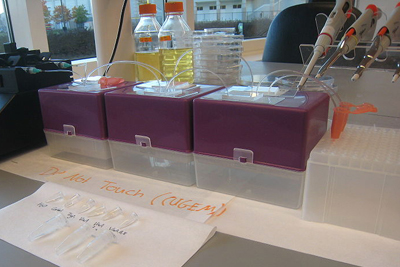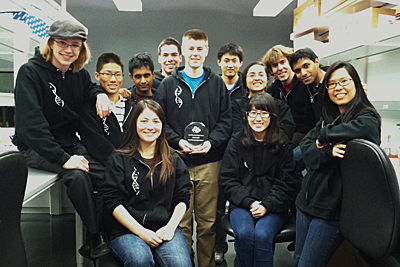Undergrad synthetic biology team takes a top prize at world championship
By Anne Ju


With today's most pressing problems ranging from the environment to health care, it's clear that life scientists and engineers need to work together. A Cornell undergraduate project team, only three years old but already winning international accolades, is getting in at the ground floor.
CU GEM (Cornell University Genetically Engineered Machines), a mostly undergraduate, highly interdisciplinary project team that started in 2008, achieved its highest honor yet at the iGEM 2011 World Championship Jamboree, Nov. 5-7.
Presenting their tested and working "Biofactory" -- a series of microfluidic chips that use a biosynthetic pathway to produce a useful chemical -- the students beat out 120 other teams to take the "Best Manufacturing Project" prize. CU GEM had previously won a gold medal at the iGEM Americas regional competition in October, catapulting them among 60 others to the worlds.
"At Cornell, our goal is to foster future leaders," said Xiling Shen, assistant professor of electrical and computer engineering and team adviser. "We are not trying to have research superhumans who can do it all, but to learn how to harness other people's expertise."
The nature of CU GEM's successful BioFactory project says it all. The goal of the project involved molecular biology, chemistry and chemical engineering -- using a known biosynthetic pathway to convert tryptophan into prodeoxyviolacein, a useful precursor to some biopharmaceuticals. The device, an array of chips etched with microfluidic channels and lined with modified enzymes that act as a linear biochemical pathway, were made in the Cornell nanofabrication facility by electrical, mechanical engineering and materials science students.
"We're interested in developing biopharmaceuticals inside of cells," said team leader Jim Mathew '14, a chemical engineering major. "But sometimes you have a lack of reactor control when working with cells, and it's hard to get a final chemical output."
CU GEM's microfluidic reactors are a scalable, cell-free method for producing complex biomolecules, which could reduce unwanted side reactions and ultimately lead to a lower-cost method of production, Mathew said.
Virtually every area of engineering, chemistry and biology were tapped in order to make the project successful -- including mass spectrometry data to confirm their results.
"The judges said they were especially impressed with how we tied everything together," said Malinka Walaliyadde '12, senior undergraduate adviser.
The projects were scrutinized on technical details as well as ethical considerations. Teams were also judged by their commitment to outreach and helping public school students, for example, gain access to science. In its short duration, CU GEM has hosted outreach events at both the Ithaca Sciencenter and at Cornell's CURIE Academy, and has already sprouted an alumni network.
Shen also pointed out that Cornell's relatively young team beat out more established teams from other top institutions. They were one of the few who came with an entire working system, rather than staying on a conceptual level.
The team's interdisciplinary nature is evidenced through its growing list of sponsors: The College of Engineering, Department of Electrical and Computer Engineering, Weill Institute for Cell and Molecular Biology, Cornell Institute for Biotechnology and Life Sciences, and Cornell NanoScale Science and Technology Facility. They have also garnered corporate sponsorship from Corning Inc., New England Biolabs, Integrated DNA Technologies and Modo.
CU GEM is breaking into a relatively new field called synthetic biology, said Shen, who teaches the course Introduction to Systems and Synthetic Biology, which has doubled as a recruiting ground for CU GEM.
The team hopes to pique the interest of freshmen and sophomores especially. Their next information session will be Dec. 3, 3-4 p.m. in 120 Physical Sciences Building.
Get Cornell news delivered right to your inbox.
Subscribe